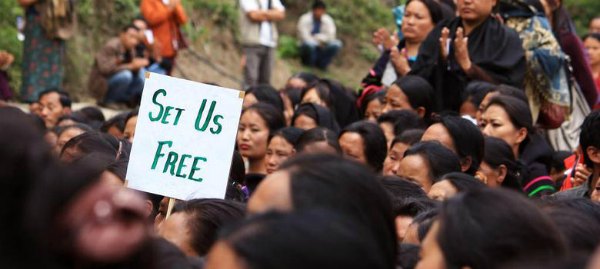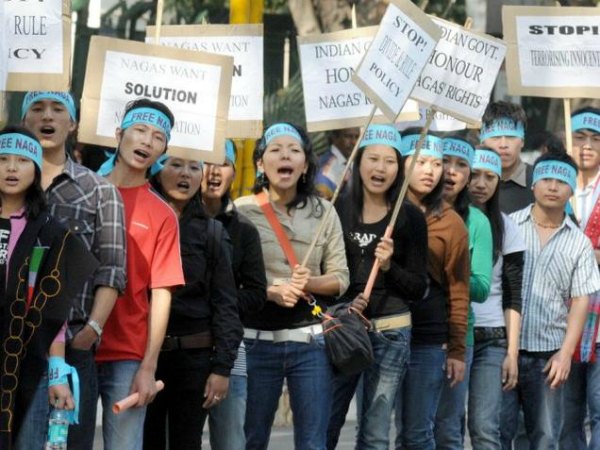There are more than 100 tribal groups in the entire north-east region of India. They have a rich cultural heritage with a variety of language and customs. During the British era, they constituted an overwhelming majority of the population in most of the areas to any significant extent. The British gave a special administrative status to these areas. The British government did not disturb their socio-political structure and followed a deliberate policy of excluding the outsiders.
After Independence, the Government of India focused on people to people contact and gave a special attention to tribal policy. The security situation in some of the north-eastern states has remained complex for a long time because of a number of militant outfits and their diverse demands. Assam, Manipur & Nagaland have continuously been a point of worry.
Rajiv Gandhi’s Mizoram Peace Accord
There is no iota of doubt that even Mizoram was a concern for Govt of India albeit it has been sorted out by Prime Minister of India, late Rajiv Gandhi in a very peaceful manner with his sincere and dedicated effort. Among the ethnic and secessionist conflicts, the resolution of the Mizoram issue was a notable success. Armed insurrection had persisted in Mizoram for more than two decades. The movement by the Mizo National Front had racial and religious overtones and its declared aim was a secession of Mizoram from the Indian Union. There was an armed uprising in 1966 and violent conflict continued well into the 1980’s. The Mizoram Accord of June 1986 succeeded in bringing the violent conflict of the past decades to a satisfactory conclusion.
Three factors may be said to have contributed to this historic conflict resolution:
- Firstly, Prime Minister Rajiv Gandhi’s sincere, dedicated and positive gesture was greatly appreciated by the people of Mizoram and its leaders which laid the initial foundation for negotiations.
- Secondly, the maturity of the two Mizo political personalities of the time.
- Thirdly, the moderating influence and pressure of the civil society, especially the women who had been the most aggrieved and affected during the period of violence.
In June 1986, the Govt of India signed a peace agreement with leaders of Mizo National Front. By its term, MNF rebels laid down their arms and were granted amnesty against prosecution. The agreement raised the prospect of the return of peace to the state of Mizoram. Peace brought its own dividend in the form of water pipelines, roads and above all schools. By 1999, Mizoram had overtaken Kerala as India’s most literate state. Since they also speak fluent English (the state’s own official language), young Mizos, men as well as women have found profitable employment in the growing service sector, in hotels and airlines in particulars.
Narendra Modi’s Nagaland Peace Accord
The moot question arises here is that the peace accord signed between the Indian government at the hegemony of Shri Narendra Modi and the National Socialist Council of Nagalim (Isak-Muivah) on August 3, stunned most of the Nagas as it came earlier than anticipated. However, the ambiguous nature of this agreement as a “preamble” between the government and NSCN (I-M) to press for a final solution has made many Nagas apprehensive. They are of the view that by signing this agreement, the NSCN (I-M) has placed the trust and confidence of the Nagas in the hands of the Central government while the Naga people, civil societies, and the Legislative Assembly is left wandering in the dark on its contents. The people are hoping that the NSCN (I-M) will not betray the Naga people on their promise of an “honourable” and “acceptable” solution.
Regrettably, even Nagaland Chief Minister T R Zeliang and the lone LokSabha MP from the state Neiphiu Rio was not known to the contents of the “framework agreement”. Luckily for Modi, the duo heartily welcomed the peace accord. This brings us to the question of inclusiveness and the will of the Nagas and whether the “final solution” will be applicable for all Nagas across the board. However, this hurriedly signed accord has slightly fragmented the “Nagas of Nagaland” and the “Nagas of Manipur”.
Through the accord Modi may have sent a strong signal to China, but this could also have fallouts with the other North-eastern states. Far from the positivity that is reported and speculated in the Indian media, the prospect of integrating Naga-inhabited areas – the idea of merging parts of Manipur, Arunachal Pradesh and Assam – with the present state of Nagaland is enough to create tensions resulting in law and order problem. To make use of this peace accord to their advantage, the Centre might attempt to isolate another NSCN faction, NSCN (Khaplang). This will further divide an already divided Naga house – the Eastern Naga, Nagas of Manipur and Nagas of Nagaland.
In the light of this problem, the objective of “honourable” and “acceptable” Naga solution is not achievable. Not long after the government and NSCN (I-M) signed the accord, different Naga political groups expressed their views and their stance.
A year has passed since the signing & one may be tempted to come to a logical conclusion regarding the reasons for the ‘framework’ in not being finalized. The contours are emerging but the ‘principles of negotiation’ seem to be paradoxically loaded and needs to be deliberated in clearer terms.
This brings us to the larger question of what is a ‘framework agreement’. Can an ‘agreement’ be made based on a framework? A framework agreement is an agreement between two parties that recognizes that the parties have not come to a final agreement on all matters relevant to the relationship between them. So, we have here what is generally known as ‘framework agreement,’ an agreement signed though clearly not finalized.
Thus, underlying the ‘framework’ there are ‘principles’ on which negotiations are being made currently, rather than agreed. So, more aptly, the Naga Political journey is ‘working’ on certain ‘principles of negotiation’ based on which a ‘final solution/settlement’ is to be arrived at.
The question of integration and sovereignty lie at the core of the ‘principles of negotiation’ and their status will be based on the outcome of the negotiations.
Conclusion: The Mizoram peace Accord signed by Prime Minister Rajiv Gandhi on 1986 which is a historic agreement and appreciated by the people of Mizoram and it’s a huge success for the Government of India but the Nagaland peace accord 2015 signed by Prime Minister Narendra Modi is a sure shot of failure as the people of Nagaland, civil society de facto nobody is aware of this agreement even the chief minister is unaware of the semantics of this agreement. Perhaps this accord fuelled a more destructive situation for the people of Nagaland.
The article was first published here
Do Not Miss Reading:
The Suicide of Rohith Vemula and the Political Musical Chair
India-Pakistan Relations : Geo-strategic Implications For India’s Pakistan Policy
The 1962 War : Why It Should Feature More Prominently in School Curriculum




